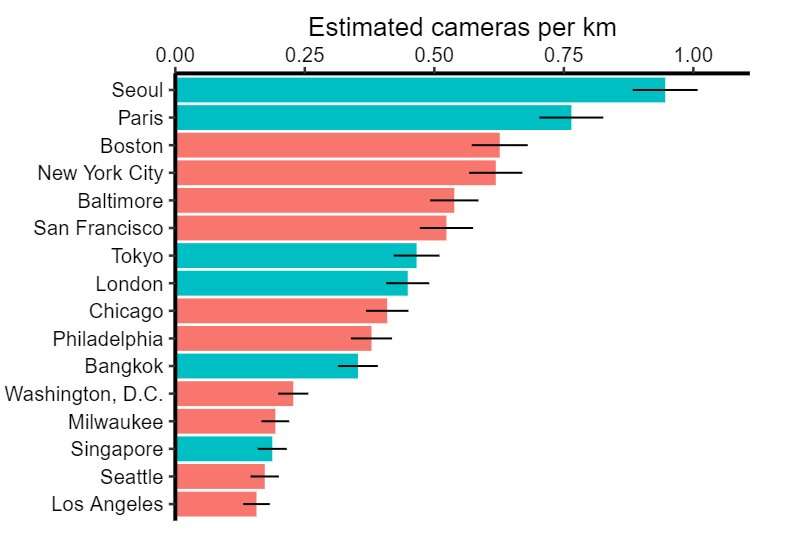Study estimates the prevalence of CCTV cameras in large cities worldwide
Over the past few decades, surveillance cameras, also known as closed-circuit television (CCTV) cameras, have become widely used by governments, law enforcement officers and private citizens to monitor public spaces, prevent crime and identify criminals. While the millions of surveillance cameras installed worldwide can play a crucial role in the prevention of crime and aid police investigations, they can also considerably restrict the privacy of citizens.
When combined with emerging facial recognition technology, surveillance cameras can become even more intrusive, as they enable the identification, monitoring and tracking of individuals. Moreover, advanced surveillance systems could hinder freedom of speech, by dissuading people from participating in public gatherings or protests for fear of being identified and persecuted.
While some studies have estimated the amount of CCTV cameras installed in cities worldwide, only a few have identified their exact locations. This makes it harder to assess the impact of large-scale surveillance systems and the extent to which they might be invading the privacy of citizens.
Researchers at Stanford University have recently carried out a study aimed at investigating the prevalence and locations of surveillance cameras in large cities in the U.S. and in other countries worldwide. Their paper, presented at the AAAI/ACM Conference on Artificial Intelligence, Ethics and Society, introduces a computer vision algorithm that can estimate the spatial distribution of surveillance cameras by analyzing Google street view and other street view images.
"Our main goal was to understand the number and location of surveillance cameras in large cities around the world," Hao Sheng, one of the researchers who carried out the study, told TechXplore. "Because collecting such data manually is often prohibitively expensive, we sought to develop methods that could be easily scaled up. As digital documentation of urban landscapes and computer vision technology have both advanced considerably in recent years, we thought that applying computer vision algorithms to existing street-view images might be possible."
In their study, Sheng and his colleagues followed three key steps. Firstly, they extracted street view images of 100,000 randomly sampled locations in each of the cities they examined. They specifically focused on 10 large cities in the U.S. (LA, New York, Chicago, Philadelphia, Seattle, Milwaukee, Baltimore, Washington D.C., San Francisco and Boston) and 6 other cities worldwide (Tokyo, Bangkok, London, Seoul, Singapore and Paris).

Estimated camera density (cameras per km) for 10 large U.S. cities and 6 other major cities for the period 2016–2020. Credit: Sheng, Yao & Goel.
Subsequently, the researchers ran a computer vision algorithm on the street view images they extracted to automatically detect surveillance cameras captured in them. Finally, they asked human participants to browse through the images and verify the validity of the results gathered by the algorithm (i.e., confirm whether it accurately spotted the cameras).
"Our method combines the merits of computer vision models (which can be quickly deployed on millions of images) and humans (who can visually identify cameras with higher accuracy)," Sheng explained. "So, even if cameras only comprise a small percentage of street view images, we can still efficiently and accurately identify them."
The analyses carried out by Sheng and his colleagues yielded several interesting results. Firstly, the researchers found that the density of cameras in cities was highly correlated with the specific uses of given locations and with the racial profile of neighborhoods. For instance, they found that cameras were more likely to be installed in a city's commercial, industrial and mixed areas than in public or residential areas.
"Even after controlling for land use, we found a much higher density of cameras in majority-minority neighborhoods than in predominantly white neighborhoods," Sheng said. "We are still trying to understand the mechanism that drives these patterns, but our findings suggest that communities of color are disproportionately surveilled."
The findings gathered by this team of researchers could have important implications for the future installation of CCTV cameras in urban environments. For instance, they could spark ethical debates about the reasons for the intense monitoring of racial minorities or general discussions about the impact of large-scale surveillance on citizen's privacy.
In their next studies, Sheng and his colleagues plan to use the computer vision algorithm they developed to examine the prevalence of other types of cameras as well, such as doorbell cameras. Doorbell cameras, such as Google Nest and Amazon Ring, allow people to see whether someone is at the door and remotely communicate with visitors via their smartphone. In recent years, these smart doorbell systems have become particularly popular, particularly in residential neighborhoods.
"Some studies estimate that the number of doorbell cameras may have surpassed traditional surveillance cameras," Sheng said. "Measuring their prevalence will thus further our understanding of the extent of surveillance in our communities. We also suspect that they may be good proxies of social trust in a neighborhood. Of course, doorbell cameras are usually smaller, thus harder to identify from street view images, which might pose new challenges for our camera detection process."
- Karlston
-

 1
1



Recommended Comments
There are no comments to display.
Join the conversation
You can post now and register later. If you have an account, sign in now to post with your account.
Note: Your post will require moderator approval before it will be visible.